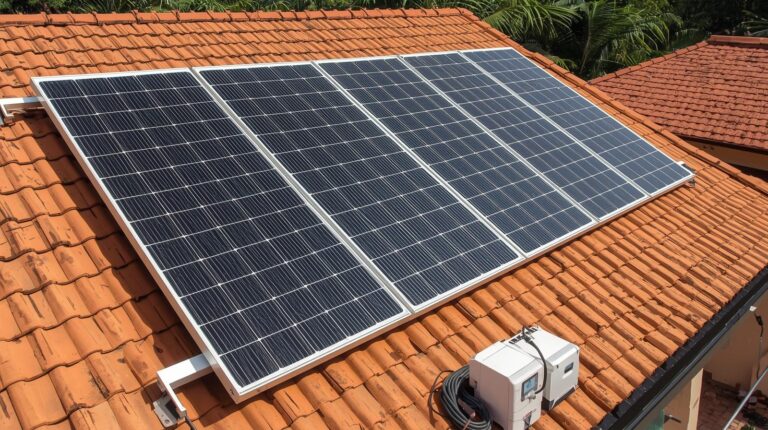As the global emphasis on sustainable energy solutions intensifies, optimizing the efficiency of home solar energy system has become imperative. While the installation of solar panels is a significant step toward energy independence, the true potential of these systems is often not fully realized due to suboptimal configurations and overlooked maintenance practices.
Addressing these gaps not only maximizes the energy output but also extends the lifespan of the system, ensuring a better return on investment. The question then arises: what are the most effective strategies to enhance the efficiency of your home solar setup, and how can you implement these to not only meet but exceed your energy needs?
Key Takeaways
- Optimize solar panel orientation towards true south and adjust the tilt angle to match local latitude for maximum sunlight capture.
- Install solar trackers to increase sunlight exposure by 20-50%, significantly enhancing energy production.
- Use microinverters to minimize the impact of shading on panels and improve overall system output.
- Regularly clean panels and remove obstructions to maintain efficiency, ideally twice a year or as conditions demand.
- Integrate advanced storage solutions like lithium-ion batteries to manage excess energy and ensure power availability during low production periods.
Calculating Solar Panel Output
To effectively calculate solar panel output, begin by determining the panel’s rated wattage and multiplying it by the average number of sunlight hours per day. For example, a typical panel rated at 250 watts receiving about 5 hours of sunlight daily would produce 1,250 daily watt-hours. Converting this to kilowatt-hours, the panel generates about 1.25 kWh daily. This basic formula is pivotal in understanding the potential energy produced by your solar energy system.
For homeowners with a solar array consisting of multiple panels, the cumulative wattage should be used. If you have four 250-watt panels, the total wattage is 1,000 watts. Multiplied by the same 5 hours of sunlight, this solar array would yield 5 kWh each day. Such calculations are essential for maximizing the efficiency of solar panels and guaranteeing that your solar energy setup achieves peak efficiency.
Additionally, employing a solar irradiance meter can fine-tune these estimates by providing accurate measurements of solar energy received, factoring in localized insolation data which vary with geographic location and season. This approach guarantees precise calculations, helping homeowners liberate themselves from reliance on non-renewable energy sources by optimizing their solar panel output.
Identifying Efficiency Obstacles
Identifying efficiency obstacles is vital for enhancing the performance of home solar energy systems. Several factors can hinder the maximum efficiency of these systems, demanding vigilant assessment and proactive management.
Shade from trees or nearby structures is a major barrier. Even minimal shading can lead to considerable decreases in energy output. Regular cleaning of the panels is also essential. Layers of dust, dirt, and bird droppings can block sunlight exposure, severely impairing solar panel efficiency and causing noticeable performance drops.
Additionally, the orientation or tilt of panels plays a critical role in capturing sunlight. Incorrect positioning can prevent panels from operating at their peak efficiency. Here’s a breakdown of common efficiency obstacles:
| Obstacle | Impact on Efficiency |
|---|---|
| Shade from Trees | Reduces energy output greatly |
| Dirt and Debris | Decreases performance by blocking sunlight |
| Incorrect Orientation/Tilt | Prevents ideal sunlight capture |
Addressing these efficiency obstacles systematically will enhance the functionality and output of your solar energy system, ensuring that you harness the full potential of solar power in your journey towards energy liberation.
Enhancing Energy Production
Addressing the efficiency obstacles previously discussed sets the stage for enhancing energy production in home solar systems. By focusing on strategic improvements, homeowners can greatly boost the performance of their solar panels and achieve greater energy independence. These enhancements are not only practical but are also vital for maximizing efficiency and reducing environmental impact.
- Optimal Panel Orientation and Tilt: Position solar panels towards true south with an angle equal to the local latitude to optimize sunlight exposure and maximize energy production year-round.
- Use of Solar Trackers: Implement solar trackers to allow panels to follow the sun’s trajectory, increasing sunlight capture by 20-50%, which greatly enhances overall efficiency.
- Installation of Microinverters: Equip solar panels with microinverters to improve the output of each panel individually by mitigating shading effects and optimizing performance.
- Integration of Energy Storage Systems: Add energy storage solutions like lithium-ion batteries to store excess energy produced during peak sunlight hours for use during lower production periods, thereby stabilizing energy supply and increasing utility.
These steps guarantee that each solar system operates at peak potential, reducing reliance on traditional power sources and promoting a sustainable energy future.
Maintenance and Cleaning Protocols
Regular maintenance and cleaning of solar panels are fundamental for maintaining ideal energy efficiency and prolonging the lifespan of the system. Dust and debris can greatly hinder the performance of your solar panels, potentially reducing their effectiveness by 25-30%. To combat this, it is important to clean your panels at least twice a year. This regular maintenance guarantees that your solar panels operate at peak efficiency.
Biannual inspections are critical in detecting any accumulation of dirt or potential obstructions that could impact energy production. During these inspections, care should be taken to use soft cloths or sponges to avoid scratching the panels while removing contaminants. This gentle approach helps preserve the integrity of the panels and optimize the efficiency of your solar energy system.
Additionally, integrating a monitoring system can be highly advantageous. Such systems enable homeowners to track the energy production of their solar panels in real-time. Any sudden drops in output can quickly be traced back to dirt accumulation or other issues, prompting timely cleaning or maintenance interventions.
For areas that are difficult to reach, hiring professional cleaning services is advisable. These experts can guarantee that the cleaning is done safely and effectively, particularly for rooftop installations, thereby sustaining the high performance of your solar energy system.
Advanced Solar Technologies
Harnessing the latest advancements in solar technology, several innovative solutions have emerged to greatly enhance the efficiency of solar energy systems. These advancements not only boost electricity generation but also contribute considerably to the broader adoption of renewable energy, propelling us towards a more sustainable and energy-independent future.
- Bifacial Solar Panels: Utilizing both sides to capture sunlight, these panels can increase energy production by 10-20%, especially beneficial in reflective environments. This dual-sided feature maximizes the use of available space and light, markedly improving system efficiency.
- Perovskite Solar Cells: Known for their high efficiency, exceeding 25% in lab tests, perovskites offer a cheaper alternative to traditional silicon cells. Their lower production costs and superior performance optimization potential make them a promising solution for future solar applications.
- Smart Solar Panels: Integrated with IoT technology, these panels enable real-time monitoring and remote management, enhancing performance optimization and ensuring peak efficiency in energy production.
- Solar Concentrators: By focusing sunlight onto high-efficiency solar cells, concentrators considerably boost the power output, making the most of every beam of light.
These technologies represent a leap forward in our quest to optimize renewable energy sources, ensuring that solar power remains a key player in the global energy landscape.
Solar Storage Solutions
Building on the momentum of advanced solar technologies, solar storage solutions now play a vital role in maximizing the utility and economic benefits of solar energy systems. With the advent of lithium-ion batteries and advanced battery management systems, homeowners can now effectively store excess energy generated during ideal solar hours for later use. This capability not only enhances energy independence but also greatly reduces energy costs by minimizing reliance on grid electricity during peak demand periods.
Solar storage solutions, such as battery storage and flow batteries, are essential in achieving a sustainable energy model. Flow batteries, in particular, offer scalability and a longer cycle life, which are beneficial for larger solar installations. Additionally, net metering policies empower homeowners by allowing them to sell surplus energy back to the grid, further offsetting installation and operational costs and promoting energy liberation.
| Type | Benefit | Suitable For |
|---|---|---|
| Lithium-ion | High energy density, Efficiency | Small to medium installations |
| Flow Batteries | Longevity, Scalability | Large installations |
| Net Metering | Cost reduction, Grid relief | All solar users |
These solar energy storage options guarantee that homeowners can manage energy production and consumption more strategically and sustainably.
Related Post: The Best Solar Power Technologies for Homes.
Financial Incentives and Benefits
Financial incentives and benefits greatly enhance the attractiveness of adopting solar energy systems for homeowners. These economic advantages make the shift to renewable energy not only environmentally responsible but also financially wise. By reducing the upfront investment and increasing the returns, these incentives create a compelling case for homeowners considering solar installation.
- Federal Solar Tax Credit: Homeowners can deduct 26% of the cost of their solar system installation from their federal taxes, notably reducing initial outlays.
- State Rebates and Incentives: Various states offer additional financial incentives, which can lower the cost of solar systems further, increasing the affordability and speeding up the return on investment.
- Net Metering: This policy allows homeowners to earn credits for surplus energy produced, which can be used to offset future energy bills, enhancing long-term savings.
- Performance-Based Incentives: Some utility companies reward homeowners based on the actual electricity their solar systems generate, providing an ongoing income stream.
Investing in solar power not only lowers utility costs but also increases the property value, ensuring that the benefits of solar systems extend beyond immediate financial savings to long-term financial gains. This strategic investment secures a liberated and sustainable future, leveraging both personal and environmental benefits.
Conclusion
In summary, optimizing home solar energy systems requires a multifaceted approach that includes calculating accurate solar panel output, identifying and addressing efficiency obstacles, and adopting advanced technologies.
Regular maintenance and cleaning are essential for sustaining peak performance. Furthermore, integrating solar storage solutions and understanding the financial incentives available are important for maximizing benefits.
These strategies collectively enhance the efficiency and sustainability of home solar energy systems, thereby supporting both economic and environmental objectives.




